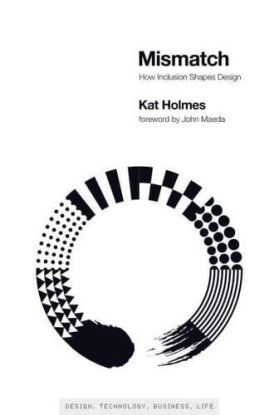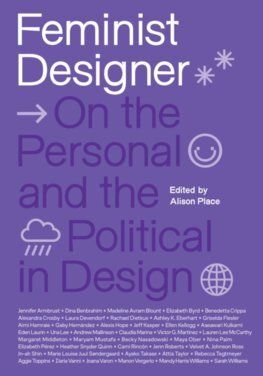MIT Press Ltd strana 3 z 3
vydavateľstvo
Mismatch
How inclusive methods can build elegant design solutions that work for all.Sometimes designed objects reject their users: a computer mouse that doesn't work for left-handed people, for example, or a touchscreen payment system that only works for people who read English phrases, have 20/20 vision, and use a credit card. Something as simple as color choices can render a product unusable for millions. These mismatches are the building blocks of exclusion. In Mismatch, Kat Holmes describes how design can lead to exclusion, and how design can also remedy exclusion. Inclusive design methods—designing objects with rather than for excluded users—can create elegant solutions that work well and benefit all.Holmes tells stories of pioneers of inclusive design, many of whom were drawn to work on inclusion because of their own experiences of exclusion. A gamer and designer who depends on voice recognition shows Holmes his "Wall of Exclusion," which displays dozens of game controllers that require two hands to operate; an architect shares her firsthand knowledge of how design can fail communities, gleaned from growing up in Detroit's housing projects; an astronomer who began to lose her eyesight adapts a technique called "sonification" so she can "listen" to the stars.Designing for inclusion is not a feel-good sideline. Holmes shows how inclusion can be a source of innovation and growth, especially for digital technologies. It can be a catalyst for creativity and a boost for the bottom line as a customer base expands. And each time we remedy a mismatched interaction, we create an opportunity for more people to contribute to society in meaningful ways.
Design after Capitalism
How design can transcend the logics, structures, and subjectivities of capitalism: a framework, theoretical grounding, and practical principles.
The designed things, experiences, and symbols that we use to perceive, understand, and perform our everyday lives are much more than just props. They directly shape how we live. In Design after Capitalism, Matthew Wizinsky argues that the world of industrial capitalism that gave birth to modern design has been dramatically transformed. Design today needs to reorient itself toward deliberate transitions of everyday politics, social relations, and economies. Looking at design through the lens of political economy, Wizinsky calls for the field to transcend the logics, structures, and subjectivities of capitalism—to combine design entrepreneurship with social empowerment in order to facilitate new ways of producing those things, symbols, and experiences that make up everyday life.
After analyzing the parallel histories of capitalism and design, Wizinsky offers some historical examples of anticapitalist, noncapitalist, and postcapitalist models of design practice. These range from the British Arts and Crafts movement of the nineteenth century to contemporary practices of growing furniture or biotextiles and automated forms of production. Drawing on insights from sociology, philosophy, economics, political science, history, environmental and sustainability studies, and critical theory—fields not usually seen as central to design—he lays out core principles for postcapitalist design; offers strategies for applying these principles to the three layers of project, practice, and discipline; and provides a set of practical guidelines for designers to use as a starting point. The work of postcapitalist design can start today, Wizinsky says—with the next project.
Vypredané
34,68 €
36,50 €
Design for a Better World
How human behavior brought our world to the brink, and how human behavior can save us.
The world is a mess. Our dire predicament, from collapsing social structures to the climate crisis, has been millennia in the making and can be traced back to the erroneous belief that the earth's resources are infinite. The key to change, says Don Norman, is human behavior, covered in the book's three major themes: meaning, sustainability, and humanity-centeredness. Emphasize quality of life, not monetary rewards; restructure how we live to better protect the environment; and focus on all of humanity. Design for a Better World presents an eye-opening diagnosis of where we've gone wrong and a clear prescription for making things better.
Norman proposes a new way of thinking, one that recognizes our place in a complex global system where even simple behaviors affect the entire world. He identifies the economic metrics that contribute to the harmful effects of commerce and manufacturing and proposes a recalibration of what we consider important in life. His experience as both a scientist and business executive gives him the perspective to show how to make these changes while maintaining a thriving economy. Let the change begin with this book before it's too late.
Vypredané
31,30 €
32,95 €
Feminist Designer
A bold and timely collection that brings feminist theory and critical thinking to life through vital, approachable design methods and practices.
Feminist Designer brings together a constellation of voices and perspectives to examine the intersection of design and feminist theory. For decades, the feminist refrain within design has hinged on the representation and inclusion of women in the field. This collection, edited by Alison Place, however, is a call to move beyond this narrow application. Feminist design is not just about who does design—it is about how we do design and why. Feminist frameworks for design activism are now more relevant than ever, as they emphasize collaborative processes that aim to disrupt and dismantle power hierarchies while centering feminist ways of knowing and doing.
The first book in nearly three decades to address such practices in design, Feminist Designer contains essays, case studies, and dialogues by 43 contributors from 16 different countries. It engages a wide variety of design disciplines, from graphic design to disability design to algorithmic design, and explores key feminist themes, such as power, knowledge, care, plurality, liberation, and community. Through diverse, sometimes conflicting, intersectional perspectives, this book contributes new design methods informed by a multiplicity of feminisms that confront design’s patriarchal origins while ushering in new pathways for making critical and meaningful change.
Contributors
Jennifer Armbrust, Dina Benbrahim, Madeline Avram Blount, Elizabeth Byrd, Benedetta Crippa, Alexandra Crosby, Laura Devendorf, Rachael Dietkus, Ashley K. Eberhart, Griselda Flesler, Aimi Hamraie, Gaby Hernández, Alexis Hope, Jeff Kasper, Ellen Kellogg, Aasawari Kulkarni, Eden Laurin, Una Lee, Andrew Mallinson, Claudia Marina, Victor G. Martinez, Lauren Lee McCarthy, Margaret Middleton, Maryam Mustafa, Becky Nasadowski, Maya Ober, Nina Paim, Elizabeth Pérez, Heather Snyder Quinn, Cami Rincón, Jenn Roberts, Velvet A. Johnson Ross, In-ah Shin, Marie Louise Juul Sondergaard, Ayako Takase, Attia Taylor, Rebecca Tegtmeyer, Aggie Toppins, Ilaria Vanni, Joana Varon, Manon Vergerio, Mandy Harris Williams, Sarah Williams
Order without Design
An argument that operational urban planning can be improved by the application of the tools of urban economics to the design of regulations and infrastructure.
Urban planning is a craft learned through practice. Planners make rapid decisions that have an immediate impact on the ground—the width of streets, the minimum size of land parcels, the heights of buildings. The language they use to describe their objectives is qualitative—“sustainable,” “livable,” “resilient”—often with no link to measurable outcomes. Urban economics, on the other hand, is a quantitative science, based on theories, models, and empirical evidence largely developed in academic settings. In this book, the eminent urban planner Alain Bertaud argues that applying the theories of urban economics to the practice of urban planning would greatly improve both the productivity of cities and the welfare of urban citizens.
Bertaud explains that markets provide the indispensable mechanism for cities' development. He cites the experience of cities without markets for land or labor in pre-reform China and Russia; this “urban planners' dream” created inefficiencies and waste. Drawing on five decades of urban planning experience in forty cities around the world, Bertaud links cities' productivity to the size of their labor markets; argues that the design of infrastructure and markets can complement each other; examines the spatial distribution of land prices and densities; stresses the importance of mobility and affordability; and critiques the land use regulations in a number of cities that aim at redesigning existing cities instead of just trying to alleviate clear negative externalities. Bertaud concludes by describing the new role that joint teams of urban planners and economists could play to improve the way cities are managed.
Vypredané
42,28 €
44,50 €




